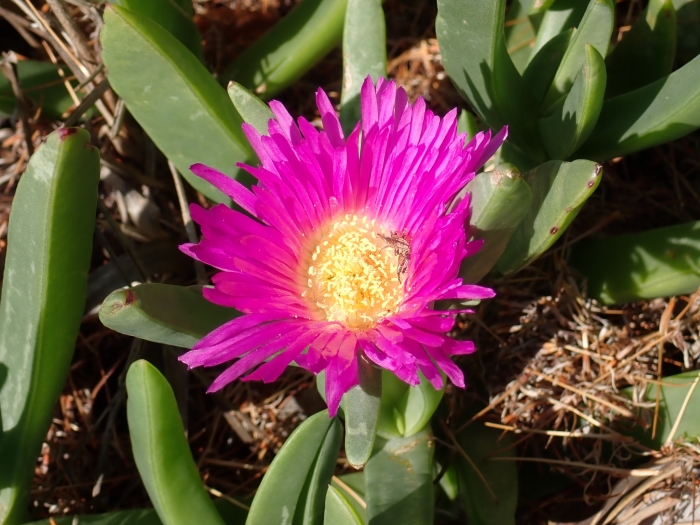Pigface
(Carpobrotus glaucescens)
Pigface (Carpobrotus glaucescens)
/
/

Milan Chytrý
CC BY 4.0
Image By:
Milan Chytrý
Recorded By:
Copyright:
CC BY 4.0
Copyright Notice:
Photo by: Milan Chytrý | License Type: CC BY 4.0 | License URL: http://creativecommons.org/licenses/by/4.0/ | Rights Holder: Milan Chytrý | Publisher: iNaturalist | Date Created: 2023-08-30T08:28:56-07:00 |
























Estimated Native Range
Summary
Carpobrotus glaucescens, commonly known as pigface or iceplant, is a succulent perennial herb native to coastal dunes and sandy soils of eastern Australia, from Mackay in Queensland to Victoria. It typically forms dense mats with fleshy, glaucous leaves and produces large, daisy-like flowers that range in color from light purple to deep pinkish-purple. The flowering season extends from late spring to autumn, with peak blooms in summer. The showy flowers are followed by edible fruits that resemble figs.
Pigface is valued for its drought tolerance, soil stabilization properties, and vibrant flowers. It is often used in coastal gardens, rockeries, and as a ground cover to prevent erosion. In cultivation, it thrives in full sun and requires well-drained soils, tolerating a range of soil types, including sandy and poor soils. While it is low maintenance and requires minimal watering once established, it is important to avoid overwatering to prevent root rot.CC BY-SA 4.0
Pigface is valued for its drought tolerance, soil stabilization properties, and vibrant flowers. It is often used in coastal gardens, rockeries, and as a ground cover to prevent erosion. In cultivation, it thrives in full sun and requires well-drained soils, tolerating a range of soil types, including sandy and poor soils. While it is low maintenance and requires minimal watering once established, it is important to avoid overwatering to prevent root rot.CC BY-SA 4.0
Plant Description
- Plant Type: Succulent
- Height: 0.5-1 feet
- Width: 3-6 feet
- Growth Rate: Moderate
- Flower Color: Pink, Purple
- Flowering Season: Spring, Summer
- Leaf Retention: Evergreen
Growth Requirements
- Sun: Full Sun, Part Shade
- Water: Low, Medium
- Drainage: Medium, Fast
Common Uses
Bee Garden, Border Plant, Butterfly Garden, Drought Tolerant, Fire Resistant, Groundcover, Low Maintenance, Rock Garden, Salt Tolerant, Showy Flowers, Street Planting
Natural Habitat
Coastal dunes and sandy soils of eastern Australia
Other Names
Common Names: Pigface, Sea Fig
Scientific Names: , Carpobrotus glaucescens, Carpobrotus abbreviatus, Mesembryanthemum abbreviatum, Mesembryanthemum glaucescens,
GBIF Accepted Name: